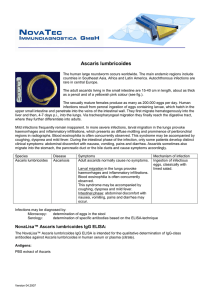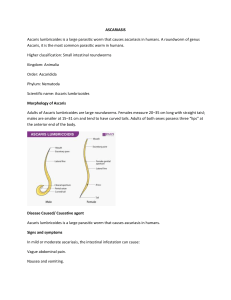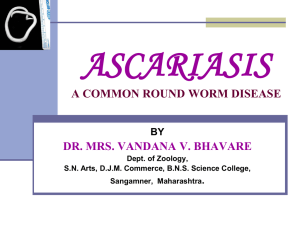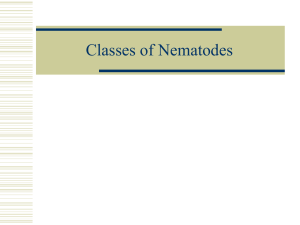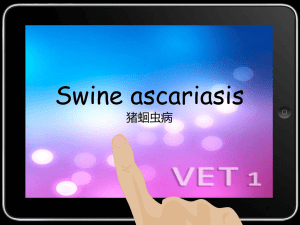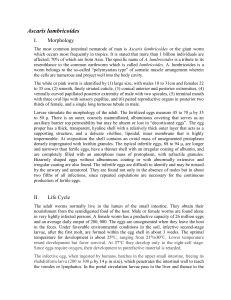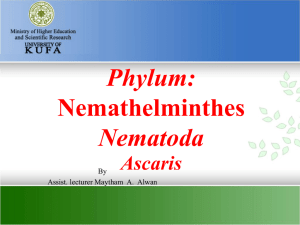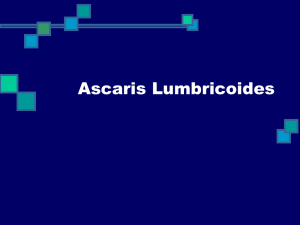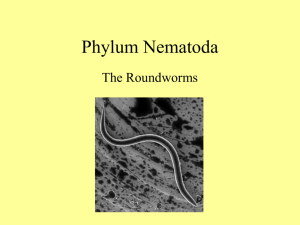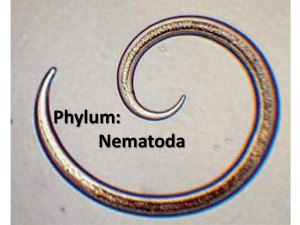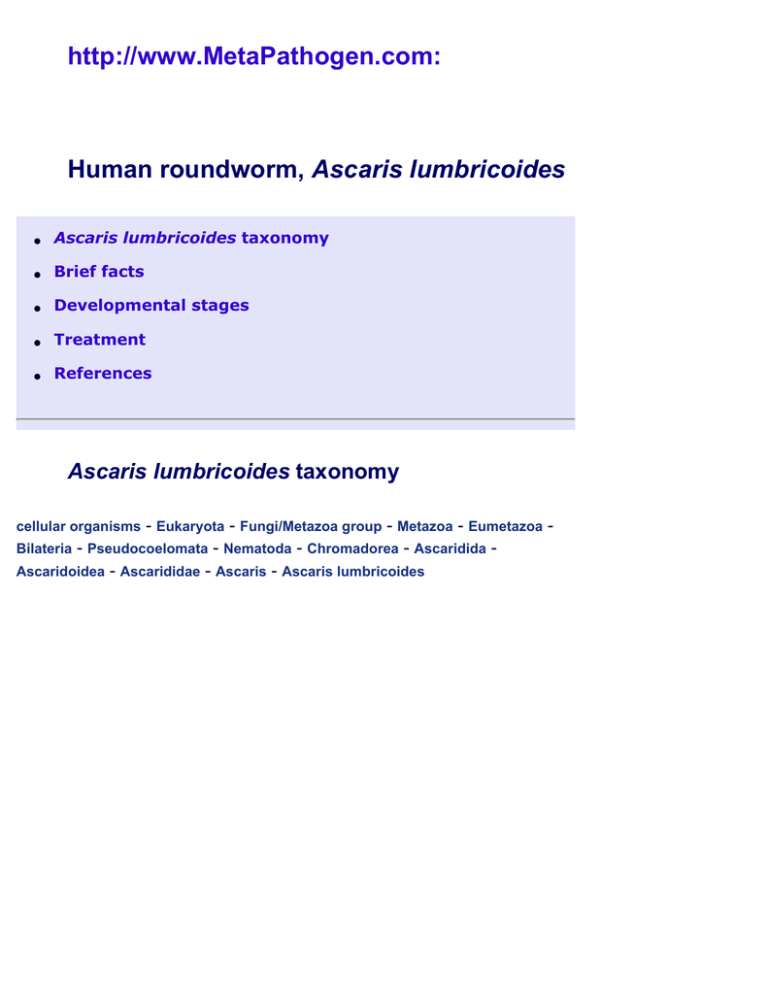
http://www.MetaPathogen.com:
Human roundworm, Ascaris lumbricoides
●
Ascaris lumbricoides taxonomy
●
Brief facts
●
Developmental stages
●
Treatment
●
References
Ascaris lumbricoides taxonomy
- Eukaryota - Fungi/Metazoa group - Metazoa - Eumetazoa Bilateria - Pseudocoelomata - Nematoda - Chromadorea - Ascaridida Ascaridoidea - Ascarididae - Ascaris - Ascaris lumbricoides
cellular organisms
Brief facts
●
●
Together with human hookworms (Ancylostoma
duodenale and Necator americanus also described
at MetaPathogen) and whipworms (Trichuris
trichiura), Ascaris lumbricoides (human roundworms)
belong to a group of so-called soil-transmitted
helminths that represent one of the world's most
important causes of physical and intellectual growth
retardation.
Today, ascariasis is among the most important
tropical diseases in humans with more than billion
infected people world-wide. Ascariasis is mostly seen
in tropical and subtropical countries because of warm
and humid conditions that facilitate development and
survival of eggs. The majority of infections occur in
Asia (up to 73%), followed by Africa (~12%) and
Latin America (~8%).
●
●
●
●
●
●
●
Ascaris lumbricoides is one of six worms listed and
named by Linnaeus. Its name has remained
unchanged up to date.
Ascariasis is an ancient infection, and A. lumbricoides
have been found in human remains from Peru dating
as early as 2277 BC. There are records of A.
lumbricoides in Egyptian mummy dating from 1938
to 1600 BC. Despite of long history of awareness and
scientific observations, the parasite's life cycle in
humans, including the migration of the larval stages
around the body, was discovered only in 1922 by a
Japanese pediatrician, Shimesu Koino.
Unlike the hookworm, whose third-stage (L3) larvae
actively penetrate skin, A. lumbricoides (as well as T.
trichiura) is transmitted passively within the eggs
after being swallowed by the host as a result of fecal
contamination.
Ascaris lumbricoides is the largest human intestinal
nematode, growing up to 35 cm in length and 0.5 cm
in diameter.
Ascariasis is classified by severity of manifestations,
which usually correlates with parasite burden. Five
types are recognized: type A is often asymptomatic,
type B causes permanent growth retardation in
children, type C is clinically overt and is characterized
by intermittent abdominal pain, nausea, anorexia,
diarrhea, type D includes acute complications that
often require hospitalization (intestinal obstructions,
biliary ascariasis, appendicitis, etc.), type E is most
severe frequently fatal disease.
The occurrence of As. lumbricoides usually peaks in
childhood and early adolescence.
Soil-transmitted helminths do not reproduce
within the host: in order to be infective their
eggs have to be released into environment
where they are embryonated (roundworms,
whipworms) or hatch into infective larvae
(hookworms). Usually the eggs as well as the
larvae do not enter the same host (the host,
who released them). This feature is crucial for
understanding of the epidemiology and
methods of control (compare with pinworm,
Enterobius vermicularis, (pinworm) at
MetaPathogen).
Developmental stages (life cycle)
Life Cycle Stages
Roundworms are dioecious, with male and female organs in separate
individuals, and have a direct life cycle (no intermediate hosts). They
mate in host's small intestine and the females produce eggs.
●
egg
single female roundworm can lay up to 240,000 eggs
per day. Eggs are passed to the environment with
feces.
❍
non-infective egg
non-infective, non-embryonated eggs, are
released into environment in the feces
❍
infective egg
in about 20 days, after embryo development,
the eggs becomes infective; under adequate
conditions, these eggs maintain their viability for
up to 1 year; they are resistant to many noxious
chemicals including acids and a number of
commercial detergents; eggs are disseminated
by rain, wind, with insects (flies), birds, and
other animals; infection in human occurs by
ingestion of eggs through contaminated food or
water, or lack of personal hygiene
●
larva
worms hatch in intestine and undergo several moltings
before developing into egg-laying adults
❍
larvae in small
intestine
eggs hatch upon reaching the host's small
intestine and penetrate the intestinal wall
❍
larvae in liver
larvae migrate to the hepatic portal circulation
invading liver in ~1-2 days after infection
❍
larvae in lungs
L3 larvae migrate up the trachea and are
swallowed after induced coughing
❍
larvae in small
intestine
L3 larvae reach the intestinal lumen after 8-9
days after infection where they molt twice and
mature at 2-3 months after infection
●
mature adult
after 2 moltings the parasites mature into adults and
mate; life span of actively feeding and egg-laying adult
females is up to 2 years; dead or paralyzed worms are
expelled from the anus
Treatment
Active agent
Albendazole
Mebendazole
Levamisole
Formulation
Advantages
Disadvantages
Tablets (200 and
400 mg); oral
suspension
Single dose of
400 mg is
effective;
ovicidal; poorly
absorbed by the
host - acts directly fetal toxicity was
on parasites;
reported in animals
similarly effective
against pinworm
and somewhat
effective against
other helminths
Tablets (200 and
500 mg); oral
suspension
Single dose of
500 mg is
effective;
ovicidal; poorly
Fetal toxicity was
absorbed by the
reported in animals
host - acts directly
on parasites;
effective against
other helminths
Tablets (40 mg)
Single dose;
highly effective
against ascariasis
Not that effective
against other
helminths; not
ovicidal;
contraindicated
during first trimester
of pregnancy
Pyrantel pamoate
Ivermectin
Tablets (250 mg)
Also highly
effective against
pinworm
Not that effective
against other
helminths; not
ovicidal;
containdicated
during first trimester
of pregnancy
Tablets,
suspensions
Broad spectrum
antiparasitic;
convenient; few
side effects
Expensive; lack of
sufficient safety data
References
PubMed articles
●
●
●
●
●
●
Bradley JE, Jackson JA. Immunity, immunoregulation and the
ecology of trichuriasis and ascariasis. Parasite Immunol. 2004
Nov-Dec;26(11-12):429-41. PMID: 15771679
Bethony J et al. Soil-transmitted helminth infections: ascariasis,
trichuriasis, and hookworm. Lancet. 2006 May 6;367
(9521):1521-32. Review. PMID: 16679166
Massara CL, Enk MJ. Treatment options in the management of
Ascaris lumbricoides. Expert Opin Pharmacother. 2004 Mar;5
(3):529-39. PMID: 15013922
Cox FE. History of human parasitology. Clin Microbiol Rev. 2002
Oct;15(4):595-612. PMID: 12364371
Shah OJ, Zargar SA, Robbani I. Biliary ascariasis: a review.
World J Surg. 2006 Aug;30(8):1500-6. PMID: 16874446
Park MS et al. Intestinal parasitic infection. Abdom Imaging.
2008 Mar-Apr;33(2):166-71. Review. PMID: 17901912
Websites
●
●
Free full text articles in PubMed: major topic "Ascaris
lumbricoides"
Center for Desease Control and Prevention: Ascaris
infection
Last updated 05/17/09
nemose@live.com
©Nemose 2008 - 2009 All rights reserved

